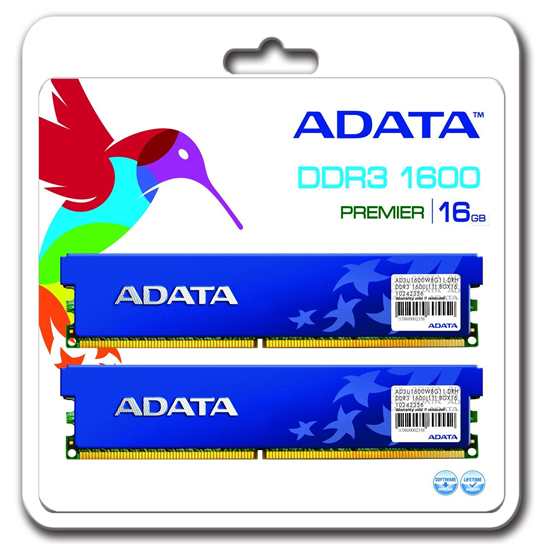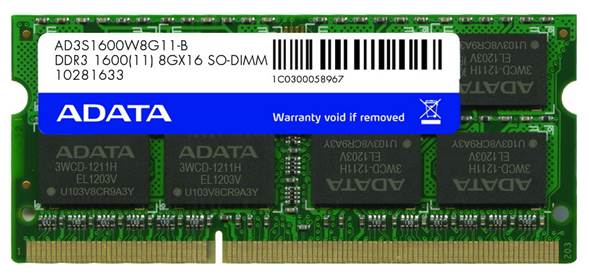Leo W. loves to stuff his PCs with
8GB or 16GB of fast dual-channel DDR3 memory, and the cost can be surprisingly
modest, onward with this week’s group.
A-Data Premier Pro 16GB DDR3-1600MHz
The model name that A-Data has selected for
this DDR3-1600 is Premier Pro, which conjures up an impression of something out
of the ordinary. The ‘something’ in this instance is a blister pack containing
two modules of memory with a large colored image of a hummingbird. As it
happens the hummingbird is A-Data’s company logo, and while the picture is both
appealing and eye-catching, it isn’t immediately obvious which aspect of the
DDR3-1600 is either Premier or Pro.

ADATA
Premier 16GB DDR3 1600MHz
A-Data sent me the Premier Pro RAM in a
plain package which focused my attention on the modules, and I wasn’t won over
by the cosmetic appeal of this memory, as it is stunningly dull.
The modules are built on green PCB with
eight chips on each side, so that’s 16 chips for each 8GB module, and there are
no heat shields to provide any visual distraction or to pretty things up. The
chips are printed with A-Data identification numbers that give no clue about the
specification or the fabrication process that was used to manufacture the dips.
I didn’t get much help from the A-Data
website, as the specification page appears to be a bit behind the times and
refers to module density of 2GB or 4GB, which rather ignored the fact that I
had 8GB modules in the test PC at that very moment.
 ADATA 8Gx16 DDR3 1600MHz
ADATA 8Gx16 DDR3 1600MHz
The only other nugget of information in the
specification is that Premier Pro runs on 1.5V but that is exactly what you
expect from memory with a rated speed of 1600MHz.
When I tested the A-Data memory, I found it
ran at 1600MHz by default on my fourth-gen Intel Core i7 test system, so there
was no need to use XMP to change the clock speed, since the memory was already
running at its maximum rated speed.
If you have an older PC that uses slower
memory settings, there are XMP profiles that might come into play, but the
numbers are a bit odd. The speeds below 1600MHz are 1370MHz and 1200MHz and in
addition I saw there’s a higher dock speed of 1676MHz on offer. This is such a
small improvement on 1600MHz that I didn’t bother to run benchmarks at this
speed, but if you’re desperate for an extra percent or two, you might consider
it worthwhile.
Performance really isn’t the object of the
exercise with the A-Data RAM, and this is brought home by the fact that
performance is slightly lower than the other memory in the group when they're
all compared at 1600MHz. In particular, the latency looks low at 57.8ns,
although the Patriot memory has similarly slow response. In the other
benchmarks the A-Data does a reasonable job, but it’s left in the dust when the
memory is run at maximum speed, because it starts as 1600MHz and has no scope
for running at a higher speed.
This means that the read bandwidth is
limited to 24,000MB/s, while faster memory such as Avexir or Kingston zooms up
no 36,000MB/s.
If you demand ultra-high performance, then
the A-Data isn’t for you, because that is not where its strength lies.
You’ll need to hunt around, as l found the
A-Data DDR3-1600 on sale for $116, but I also saw it priced at $125 on Amazon
US, so the pricing is highly variable.
Shop carefully, and if you fancy 16GB of
perfectly decent memory at a reasonable price, then you should snap up the
Premier Pro smartish.
Details
·
Price: $116
·
Manufacturer: A-Data
·
Website: www.adatagroup.com
·
Quality: 5/10
·
Value: 8/10
·
Overall: 7/10
Avexir Core Blue 8GB DDR3-2400MHz
I was looking forward to my first hands-on
experience with Avexir DDR3 memory, and it came thanks to Overclockers, which
is the sole UK outlet for this brand of memory. In fact, Overclockers sent me
three sets of Core Series memory, so l had to do a bit of reading to figure out
the difference between DDR3-1600 Core Red, DDR3-1600 Core Yellow and DDR3-2400
Core Blue.

4GB
x4 DDR3-2400C10 1.65V
The name Core suggests this particular
range of memory should live down at the basic end of the Avexir family, but
this is not the case. Avexir lists Budget, Platinum and Green models that have
the memory chips on show, and then we have Standard, Core and Blitz series,
which are covered with heat spreaders.
Core is a performance model that employs
LED lighting along the length of the module, while Blitz is a juiced up version
of Core that adds a second XMP profile to the module.
You can buy Core kits that range from
1333MHz to 2800MHz with dual-channel capacities that start at 2GB and go up to
16GB.
It’s the Red, Yellow and Blue label that
sets Avexir apart from the competition, because this describes the color of the
light in each module. I have to be honest and say I’m not usually in favor of
having lights inside my PC, because I value ease of access and decent cooling
but have little time for fans with colored LEDs in the rotating blades or
strings of fluorescent lights. I am impressed by those people who build water
cooled systems with colored coolant in clear tubes, but that’s more about the
engineering than the lighting, so I did not expect to like the Avexir Blue
DDR3-2400 RAM.

Avexir
DDR3-2400MHz
“In terms of performance the Core Blue
worked perfectly at the default speed”
I was wrong. The blue LEDS in this model
illuminate in a pattern that pulses up and down each module and flashes between
the two modules in sequence. When I added a pair of Avexir Core Yellow modules
to the other slots in the motherboard the effect was eye catching and very
appealing. I’m not certain that I want a light show inside my PC case, but if I
did go down that route, I reckon that Avexir RAM would be on my shopping list.
One downside to the inclusion of lighting
strips is that the modules are moderately tall at 30mm.
In terms of performance, the Core Blue
worked perfectly at the default speed of 1600MHz but gave problems when I
enabled XMP, as the memory was unstable and would boot into Windows but refused
to run SiSoft Sandra.
This was easily solved by manually raising
the RAM voltage to 1.65V, which allowed the Avexir RAM to run at full speed. I
asked Overclockers why the XMP profile didn‘t work correctly and it, told me
that the ASRock BIOS probably didn’t recognize Avexir, as it’s a lesser-known
manufacturer. It also offered the view that you’re best advised to ignore XMP
and use manual settings to get maximum performance.
That’s a valid point, but I feel that the
combination of UEFI and XMP in modem motherboards is taking us away from the
traditional BIOS and manual settings Enthusiasts will have no problem with
manual memory settings, but the more casual customer who is attracted by the
lure of pretty lights might find the Avexir less appealing.
When the Cote Blue is running at full
speed, you get high performance and low latency that put this memory at the top
of the group. If you feel that integrated lighting is something you desire,
then Avexir Core should be the RAM inside your PC.
Personally, I can take the lighting or
leave it and would prefer to see the price drop by $7 there is no doubt that
Core Blue stands out from the rest of the field, and that is very welcome.
Details
·
Price: $101
·
Manufacturer: Avexir
·
Website: www.avexir.com
·
Quality: 8/10
·
Value: 7/10
·
Overall: 7/10